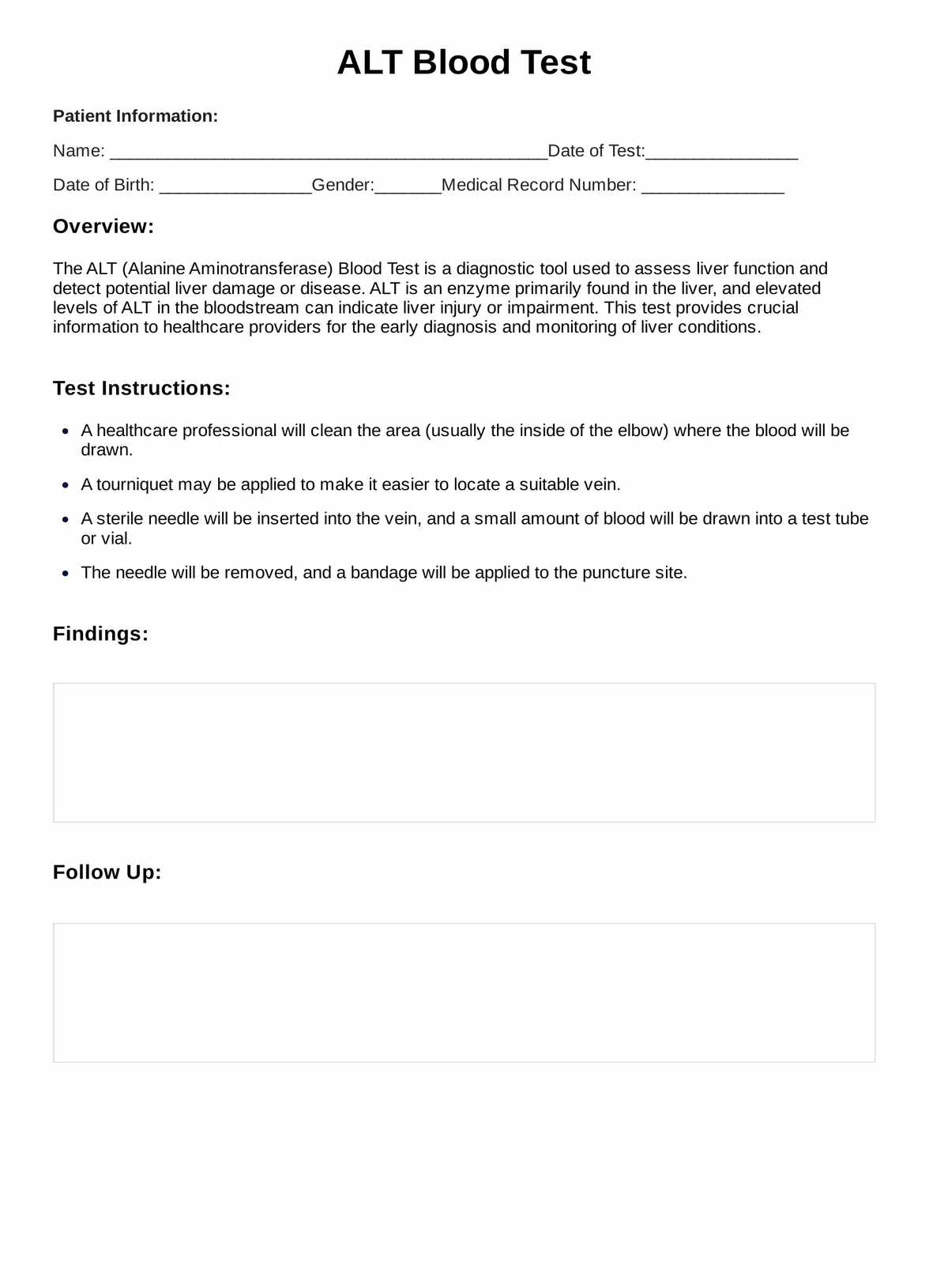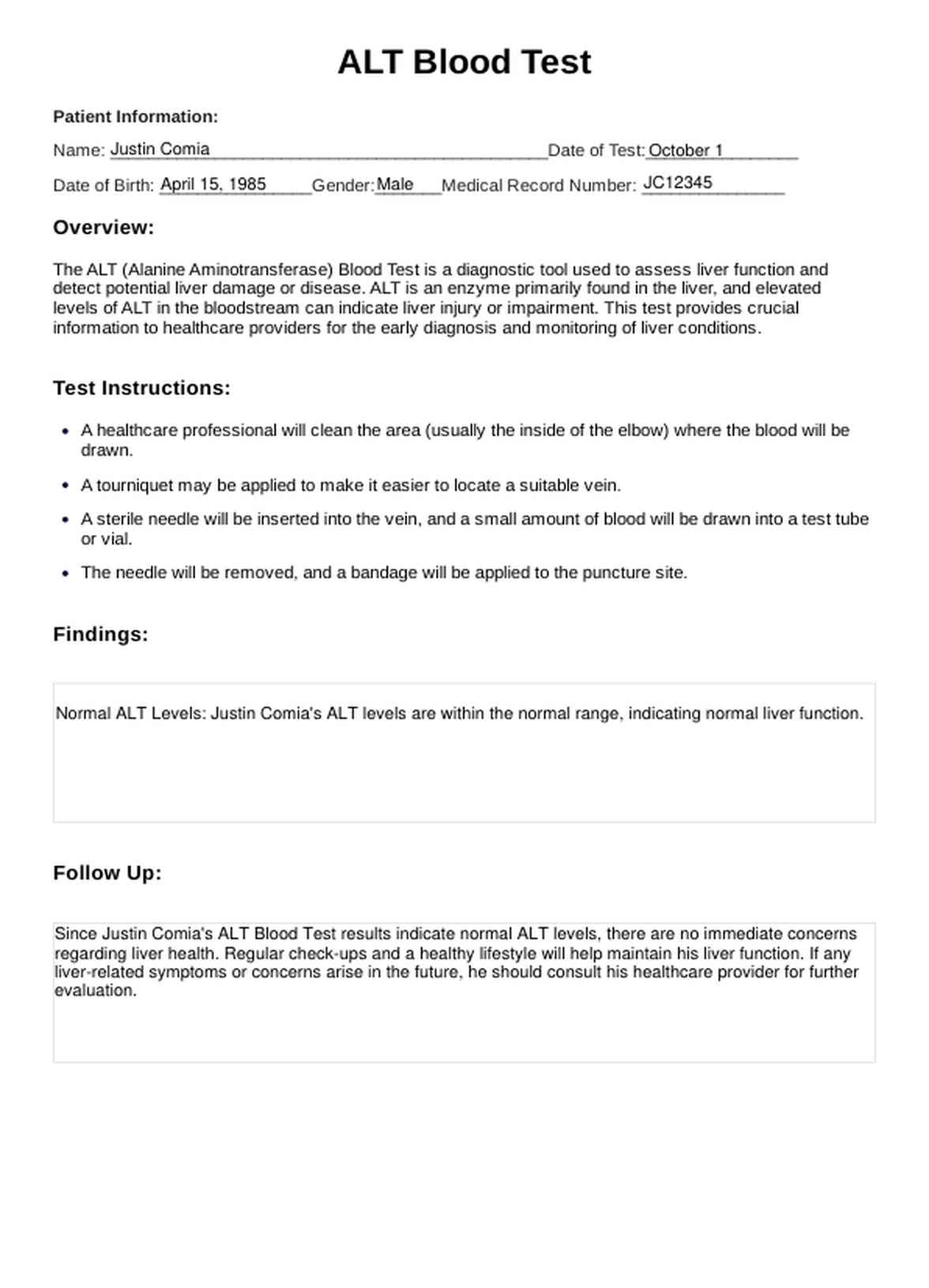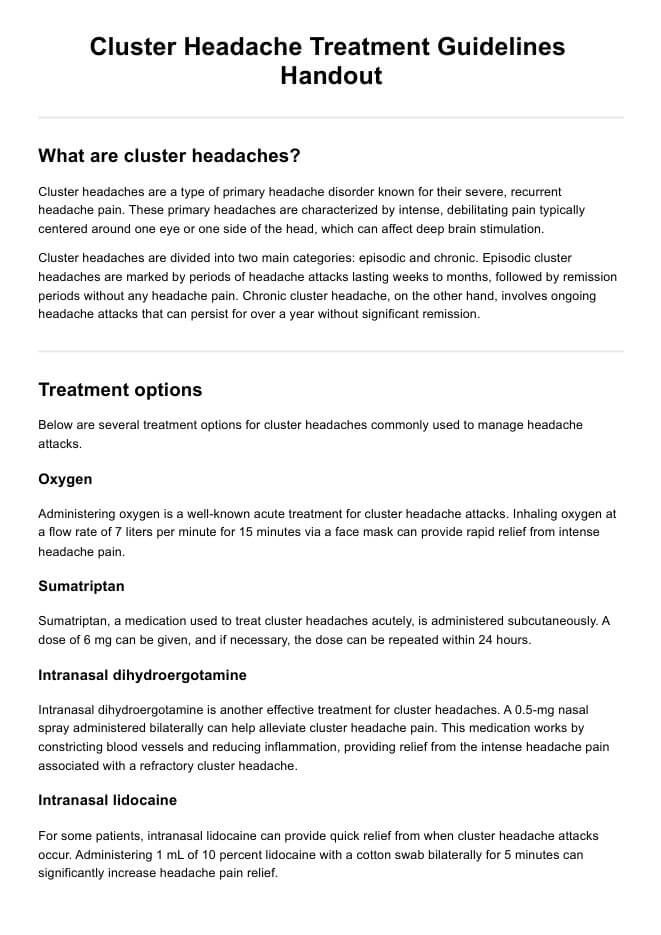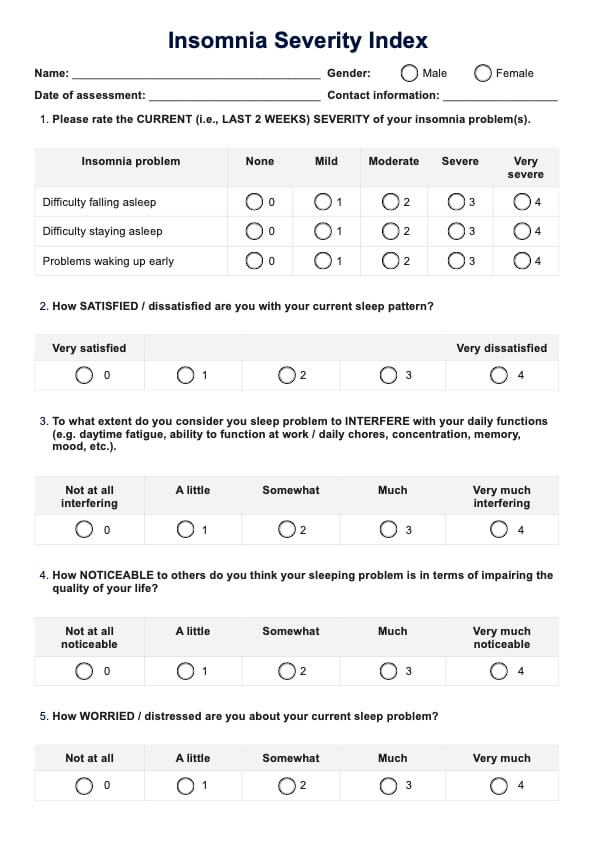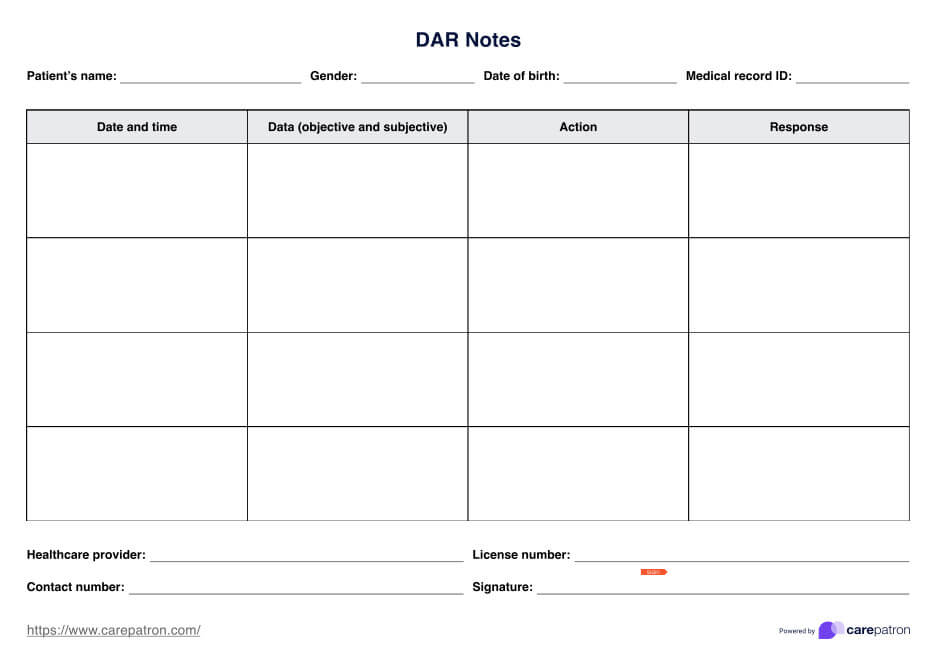ALT Blood Test
Discover the ALT Blood Test, including what it is, how it works, when to use it, and interpret results. Free ALT Blood Test example available for download.


What is an ALT Blood Test?
An ALT (Alanine Aminotransferase) Blood Test is critical to modern medicine's diagnostic arsenal, particularly in hepatology and liver health assessment. It is a powerful window into the state of the liver, one of the body's most vital organs.
The measures the concentration of ALT enzyme in the bloodstream, predominantly from the liver. ALT, an abbreviation for Alanine Aminotransferase, is an enzyme intrinsically linked to liver cell function. As liver cells, or hepatocytes, carry out their intricate metabolic processes, ALT is released into the bloodstream in trace amounts under normal circumstances; however, when the liver is under duress, whether due to injury, inflammation, or underlying disease, the release of ALT into the blood increases significantly.
Thus, an ALT Blood Test is a sensitive and reliable indicator of liver health, allowing healthcare providers to detect early signs of liver dysfunction and disease.
The significance of the ALT Blood Test lies in its diagnostic utility and role as a proactive tool for preventative healthcare. By identifying elevated ALT levels in the blood, healthcare providers can intervene before symptoms manifest, potentially averting more severe liver damage.
This preventive aspect addresses liver conditions such as viral hepatitis, non-alcoholic fatty liver disease (NAFLD), or medication-induced liver injury. Therefore, the ALT Blood Test plays a dual role in modern medicine�??both as a diagnostic cornerstone for established liver diseases and a sentinel for emerging liver issues, offering a proactive approach to safeguarding liver health.
ALT Blood Test Template
ALT Blood Test Example
How Does It Work
Understanding the mechanics of the ALT Blood Test requires delving into the meticulous process involved in its administration. When an individual undergoes an ALT Blood Test, a series of orchestrated steps are meticulously followed to ensure the accuracy and reliability of the results.
Step 1: Preparation
No specific preparations are required. However, inform your healthcare provider about any medications or medical conditions that might affect the test.
Step 2: Blood Collection
A healthcare professional will draw a small blood sample using a sterile needle, typically from a vein in your arm. The collected blood is then placed in a test tube or vial.
Step 3: Laboratory Analysis
The blood sample is sent to a laboratory for analysis. Here, the concentration of ALT enzyme is measured and reported in units per liter (U/L) of blood.
When Would You Use This Test?
The ALT (Alanine Aminotransferase) Blood Test is critical in healthcare diagnostics, especially when understanding liver health. In the following sections, we delve into the significance of this test, exploring not only what it is and how it works but also when and why it is employed.
The ALT Blood Test plays a pivotal role in the early detection, diagnosis, and monitoring of liver conditions, making it a vital resource for healthcare providers and patients.
Why Assess Liver Health?
The liver, a remarkable organ with various vital functions, including detoxification, metabolism, and nutrient storage, requires meticulous care. As liver ailments often manifest silently, without apparent symptoms in their early stages, healthcare providers rely on specialized tests like the ALT Blood Test to gauge the liver's well-being. Understanding when and why to use this test is essential for timely detection and management of liver-related issues.
The ALT Blood Test is employed in various scenarios to safeguard liver health and diagnose potential conditions. Here are some critical situations in which this test is invaluable:
1. Routine Health Checkup
Many healthcare providers include ALT testing in routine blood panels as a proactive measure to assess overall liver health. Periodic screenings, especially for individuals at risk due to factors such as family history, obesity, or alcohol consumption, help identify potential issues before symptoms emerge.
2. Diagnostic Tool
When individuals present with symptoms like jaundice, fatigue, abdominal pain, or unexplained weight loss, healthcare practitioners often request ALT Blood Tests. These symptoms may indicate liver dysfunction, and the test aids in diagnosing conditions such as hepatitis, cirrhosis, or fatty liver disease.
3. Monitoring Chronic Conditions
For individuals with known liver conditions, such as chronic hepatitis or cirrhosis, regular ALT tests are essential. They allow healthcare providers to monitor the progression of the disease, assess treatment effectiveness, and make timely adjustments to care plans.
4. Medication and Treatment Evaluation
ALT levels are closely monitored in patients taking medications that affect the liver. Elevated ALT levels during treatment can signal drug-induced liver injury, prompting healthcare providers to adjust drugs or consider alternative therapies.
5. Preoperative Assessment
Surgeons may request ALT tests before certain surgeries, especially if the procedure involves anesthesia or medications that interact with the liver. A healthy liver function is crucial for metabolizing drugs used during surgery.
The ALT Blood Test is a versatile tool for various purposes, from routine health assessments to diagnosing and managing liver conditions. Its ability to detect liver issues early makes it indispensable in maintaining overall health and well-being.
What Do the Results Mean?
Interpreting the results of an ALT (Alanine Aminotransferase) Blood Test is vital in assessing liver health. The test measures the concentration of ALT enzyme in the bloodstream, primarily from the liver. Understanding these results helps healthcare providers diagnose liver conditions and guide treatment decisions. Here's a detailed breakdown of what different ALT levels may indicate:
- Normal ALT Levels: ALT levels within the reference range, typically between 7 to 56 units per liter (U/L) of blood, generally indicate normal liver function. In such cases, no significant liver damage or disease is typically present.
- Elevated ALT Levels: Higher-than-normal ALT levels in the blood may suggest liver damage or disease. However, it's essential to recognize that ALT elevation alone does not pinpoint a specific diagnosis. Further investigation is required to determine the underlying cause. Common conditions associated with elevated ALT levels include:
- Hepatitis: Viral hepatitis (such as hepatitis B or C) and non-viral hepatitis can cause significant increases in ALT levels.
- Cirrhosis: In advanced stages of liver cirrhosis, ALT levels may rise due to ongoing liver damage.
- Fatty Liver Disease: Non-alcoholic fatty liver disease (NAFLD) and alcoholic liver disease can lead to elevated ALT levels.
- Drug-Induced Liver Injury: Some medications and drugs can cause liver damage, increasing ALT levels. You must inform your healthcare provider about any medications or supplements you are taking.
- Alcohol-Related Liver Damage: Chronic alcohol consumption can lead to liver damage and elevated ALT levels.
- Hemochromatosis: This genetic condition, characterized by excess iron absorption, can impact liver function and raise ALT levels.
- Wilson's Disease: A rare genetic disorder that affects copper metabolism and can lead to liver problems and elevated ALT levels.
- Autoimmune Liver Diseases: Conditions like autoimmune hepatitis can cause liver inflammation and elevated ALT levels.
It's important to note that while elevated ALT levels can indicate liver issues, they don't provide a definitive diagnosis. Additional tests, including imaging studies (such as ultrasound or MRI) and sometimes liver biopsy, may be necessary to determine the exact cause and extent of liver damage. Additionally, clinical evaluation, medical history, and consideration of other liver function tests are essential in making a precise diagnosis.
Following up with your healthcare provider is crucial if you receive ALT Blood Test results indicating elevated ALT levels. They will conduct a thorough assessment, review your medical history, and recommend further tests to identify and address underlying liver conditions. Early detection and intervention are vital in managing liver diseases effectively.
Research & Evidence
The ALT Blood Test, also known as the Alanine Aminotransferase Test, has a rich history of research and clinical use, making it a cornerstone in hepatology and liver health assessment. Here's an overview of the study and evidence that supports its significance:
Diagnostic Accuracy:
- Hepatitis: ALT is a well-established marker for hepatitis, both viral (e.g., hepatitis B and C) and non-viral (e.g., alcoholic hepatitis). Numerous studies have demonstrated the utility of ALT measurements in diagnosing and differentiating various forms of hepatitis.
- Cirrhosis: ALT levels often correlate with the severity of liver fibrosis in cirrhosis patients. Research has shown that monitoring ALT levels can help identify the progression of liver damage in cirrhotic individuals.
- Fatty Liver Disease: ALT is a crucial indicator in diagnosing non-alcoholic fatty liver disease (NAFLD) and its more severe form, non-alcoholic steatohepatitis (NASH). Multiple studies have confirmed the association between elevated ALT levels and NAFLD/NASH.
Monitoring and Prognosis:
- Treatment Efficacy: ALT Blood Tests are widely used to monitor the effectiveness of treatments for liver conditions. Research has demonstrated that a reduction in ALT levels often indicates a positive response to treatment.
- Liver Transplantation: ALT levels are essential in assessing the overall liver function of potential transplant recipients. Elevated ALT levels can indicate ongoing liver damage, which may affect eligibility for transplantation.
- Prognostic Value: Several studies have shown that elevated ALT levels are associated with poorer outcomes in liver diseases. ALT can be a prognostic marker, helping predict disease progression and overall patient prognosis.
Research Advancements:
- Genetic Studies: Ongoing genetic research has identified specific gene variants associated with ALT levels. These genetic factors can influence individual ALT levels and susceptibility to liver diseases.
- Novel Biomarkers: While ALT remains a valuable tool, ongoing research is exploring the use of additional biomarkers in conjunction with ALT to enhance diagnostic accuracy and disease monitoring.
In summary, the ALT Blood Test has a robust research foundation and clinical evidence supporting its role in diagnosing liver conditions, monitoring disease progression, and assessing treatment efficacy. It continues to be a fundamental tool in the hands of healthcare professionals for managing liver health and improving patient outcomes.
Reference
- National Institute of Diabetes and Digestive and Kidney Diseases
Commonly asked questions
Healthcare providers, including general practitioners, hepatologists, and gastroenterologists, typically request ALT Blood Tests.
ALT Blood Tests are used to assess liver function, diagnose liver conditions, and monitor the progress of liver diseases and treatments.
The test itself typically takes only a few minutes. However, depending on the laboratory's workload, you may need to wait for the results, which can take a day or two.


